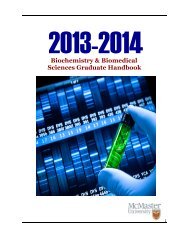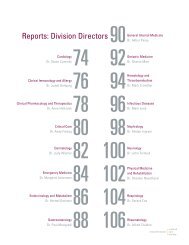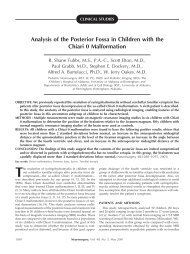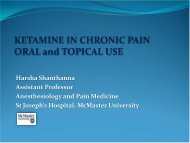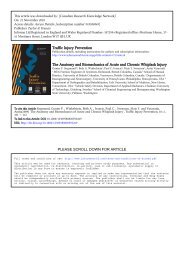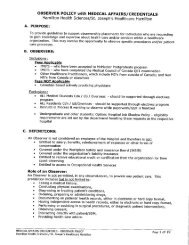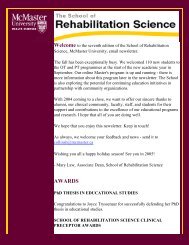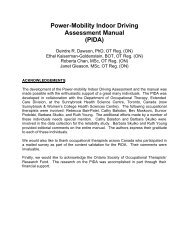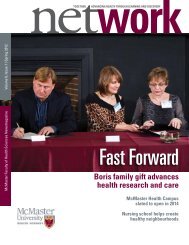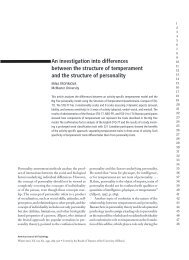IN THIS ISSUE WHAT'S NEW Porphyria Testing Demystified
IN THIS ISSUE WHAT'S NEW Porphyria Testing Demystified
IN THIS ISSUE WHAT'S NEW Porphyria Testing Demystified
You also want an ePaper? Increase the reach of your titles
YUMPU automatically turns print PDFs into web optimized ePapers that Google loves.
April 2012<br />
Issue #118<br />
<strong>IN</strong> <strong>THIS</strong> <strong>ISSUE</strong><br />
• <strong>Porphyria</strong> <strong>Testing</strong><br />
<strong>Demystified</strong><br />
• What else is in<br />
Cocaine?<br />
• Education News<br />
• Celebrating<br />
Success!<br />
WHAT’S <strong>NEW</strong><br />
• News from<br />
Chemistry<br />
• News from<br />
Pathology<br />
• News from<br />
Microbiology<br />
• News from Special<br />
Hematology<br />
Editorial Board:<br />
Chemistry: Dr C Balion<br />
Microbiology: Dr C Main<br />
Pathology: Dr J Jansen<br />
Genetics: Dr J Waye<br />
Hematology: A McFarlane,<br />
K Moffat<br />
Editorial Office:<br />
Dr Cheryl Main, Editor<br />
Email: mainc@hhsc.ca<br />
Michelina Bozzo, Editorial<br />
Assistant<br />
Email: bozzom@hhsc.ca<br />
<strong>Porphyria</strong> <strong>Testing</strong> <strong>Demystified</strong><br />
What is porphyria?<br />
<strong>Porphyria</strong>s are caused by various mutations in the enzymes that<br />
make up the heme synthetic pathway. Symptoms are exacerbated<br />
by certain drugs, particularly CYP450 inducers, stress and surgery,<br />
with sometimes fatal outcomes. Increased demand for the heme<br />
products leads to the accumulation of heme intermediate<br />
metabolites, including porphyrin precursors, porphobilinogen (PBG)<br />
and aminolevulinic acid (ALA), and/or porphyrinogens, depending on<br />
where the mutation occurs. The mechanism of the metabolite<br />
toxicity is not fully understood, but the literature most often<br />
suggests that PBG and ALA are neurotoxic, causing acute symptoms,<br />
(most commonly acute abdominal pain). In addition, it’s thought<br />
that porphyrinogens, following oxidation to porphyrins, produce free<br />
radicals when exposed to UV light, resulting in the skin damage seen<br />
in the cutaneous porphyrias.<br />
Diagnosing porphyrias<br />
Although the porphyrias are rare, it is important to quickly and<br />
effectively exclude or diagnose the porphyrias when there is<br />
unexplained abdominal pain or cutaneous manifestation, and more<br />
common causes have been excluded. Diagnosis of porphyria can be<br />
made by combining clinical information with laboratory testing for<br />
the accumulation of heme intermediate metabolites in urine, stool<br />
and/or blood. The diagnostic strategy should initially determine<br />
whether the patient is presenting with acute abdomen or cutaneous<br />
symptoms, or both.<br />
If acute porphyria is suspected, testing for urine PBG (commonly<br />
offered as the combined PBG/ALA test) is the recommended first<br />
line laboratory test. An increase in PBG (often close to 10 fold) is<br />
diagnostic of acute porphyria. Treatment can be started as soon as<br />
PBG elevation is detected, and further testing to determine the type<br />
of acute porphyria does not need to be rapid. However, it is best if<br />
all samples are collected prior to starting treatment, during an acute<br />
attack, before the metabolite levels normalize. Acute intermittent<br />
porphyria (AIP) is the most common acute porphyria. Variegate<br />
porphyria (VP) and hereditary coproporphyria (HCP) can present<br />
with cutaneous and/or acute symptoms. To differentiate between<br />
AIP, VP and HCP, urine PBG and both urine and fecal porphyrins<br />
need to be evaluated. Alternatively, plasma fluorescence emission<br />
spectroscopy can differentiate between these forms, however this<br />
test is not readily available.<br />
Your feedback, suggestions and new ideas are welcomed. Submit to the Editorial Office:<br />
Dr. Cheryl Main, Editor, Email: mainc@hhsc.ca; Michelina Bozzo, Editorial Assistant, Email: bozzom@hhsc.ca
2 LAB CONNECTIONS<br />
PBG deaminase is not the first-line test for acute<br />
porphyria, as it is diagnostic of AIP only, and levels can<br />
overlap between healthy individuals and AIP patients<br />
(due to partial enzyme deficiencies). In spite of its low<br />
performance, PBG deaminase is still recommended to<br />
aid in diagnosis of AIP between attacks (if urine PBG is<br />
inconclusive), or in family members of AIP patients.<br />
<strong>Testing</strong> other enzyme activities is rarely performed, due<br />
to limited availability and poor analytical performance.<br />
δ-aminolevulinic acid dehydratase deficiency (ADP) is an<br />
extremely rare cause of isolated ALA elevation,<br />
therefore, any isolated ALA increase should be further<br />
investigated. Lead poisoning is a common cause of ALA<br />
elevation, and tyrosinemia type I, which can be<br />
excluded by organic acid testing, is a rare disorder with<br />
increased ALA.<br />
Cutaneous porphyrias, porphyria cutanea tarda (PCT),<br />
hepatoerythropoietic porphyria (HEP) and congenital<br />
erythropoietic porphyria (CEP) can be differentiated by<br />
the presence of different porphyrin metabolites<br />
(fractions) on urine and fecal porphyrin screens<br />
followed by fractionation and quantitation. As<br />
mentioned above, VP and HCP can present with<br />
cutaneous and/or acute symptoms, therefore, they also<br />
require PBG testing. If erythropoietic protoporphyria<br />
(EPP) is suspected, total erythrocyte protoporphyrin (or<br />
free erythrocyte protoporphyrin, FEP) is the<br />
recommended diagnostic test.<br />
It is controversial whether a random or 24h urine<br />
sample is better for urine PBG/ALA and urine porphyrin<br />
testing. The 24h urine sample is generally considered<br />
more sensitive, however it may delay diagnosis, and be<br />
compromised by inadequate urine collection. In<br />
addition, 24h urine specimens are associated with more<br />
false positive results. PBG/ALA and urine porphyrins are<br />
increased several fold in acute porphyrias, thus<br />
analytical sensitivity is usually not an issue during acute<br />
attacks. Currently the HRLMP recommends 24h urine<br />
sample as the preferred sample, and a random urine<br />
sample as acceptable in acute situations. Random urine<br />
porphyrin quantitation may be used to monitor<br />
improvement during treatment of acute porphyrias.<br />
Genetic analysis to identify the causative mutation is<br />
considered the gold standard, however rarely necessary<br />
for treatment, and not indicative of disease severity. It<br />
may be considered for confirmation, and in family<br />
members of a patient in whom a mutation has been<br />
identified.<br />
Simplifying the porphyria testing at HRLMP<br />
<strong>Porphyria</strong> testing can be a complex process, as multiple<br />
intermediates must be measured to accurately assess<br />
the array of possible mutations. This is further confused<br />
by the fact that porphyrins become less water soluble<br />
as they are processed through the heme synthetic<br />
pathway, resulting in different metabolites detected in<br />
different specimen types. This complexity leads to<br />
inappropriate test ordering and delays in testing. Thus,<br />
we are proposing an "all in one" porphyria testing<br />
option (Figure 1). The suggested <strong>Porphyria</strong> Panel is an<br />
order set that would require the collection of urine and<br />
fecal samples (+/- a blood sample if EPP is suspected), at<br />
the time of order. Ordering the tests as a panel is not<br />
expected to adversely affect current turnaround times<br />
(7-12 days). We anticipate the <strong>Porphyria</strong> Panel will<br />
streamline the process of porphyria testing, ensuring<br />
that all the necessary samples are collected during, or<br />
shortly after, the attack, when levels are likely to be the<br />
highest. There will be less opportunity for inappropriate<br />
ordering, which will result in more rapid diagnosis, and<br />
contribute to improved patient care and cost savings.<br />
We welcome any comments, questions or concerns.<br />
Kristin Hauff and Kika Veljkovic, Clinical Biochemistry Fellows<br />
kristin.hauff@medportal.ca<br />
kika.veljkovic@medportal.ca<br />
Bibliography<br />
Frank, E. (2010). Porphyrins and <strong>Porphyria</strong>s. Expert Access, American<br />
Academy for Clinical Chemistry.<br />
Hindmarsh, J. T. (2003). "The porphyrias, appropriate test selection."<br />
Clin Chim Acta 333(2): 203-207.<br />
Hindmarsh, J. T., L. Oliveras, et al. (1999). "Biochemical<br />
differentiation of the porphyrias." Clin Biochem 32(8): 609-619.<br />
Mamet, R., M. Sztern, et al. (2001). "Lead Poisoning: A New<br />
Biochemical Perspective on the Differentiation Between Acquired<br />
and Hereditary Neuroporphyria." Clinical Chemistry 47(9): 1710-<br />
1713.<br />
Nuttall, K. L., S. S. Pingree, et al. (1996). "Reference intervals for 24hour<br />
and random urine porphyrins." Ann Clin Lab Sci 26(4): 313-322.<br />
Parnas, M. and E. Frank (2010). <strong>Porphyria</strong>s: a guide to laboratory<br />
assessment. Clinical Laboratory News, AACC Press. 36.<br />
Pimstone, N., K. Anderson, et al. (2011). "Emergency Room<br />
Recommendations." 2011, from www.poprhyriafoundation.com.<br />
Puy, H., L. Gouya, et al. (2010). "<strong>Porphyria</strong>s." Lancet 375(9718): 924-<br />
937.<br />
Tietz, N. W., E. R. Ashwood, et al. (2006). Tietz Textbook of clinical<br />
chemistry and molecular diagnostics. St. Louis, Elsevier Saunders.<br />
April 2012/Issue #118
3<br />
LAB CONNECTIONS<br />
Figure 1: The proposed HRLMP testing algorithm: <strong>Porphyria</strong> Panel<br />
1. Consider liver disease, alcohol and heavy metal poisoning, that may result in non-specific<br />
coproporphyrinuria; consider GI bleeding, and dietary heme that may result in non-specific proto excretion<br />
in feces.<br />
2. Random or 24h urine samples are acceptable; it is best if both urine and fecal samples are collected, prior<br />
to the start of Rx; if fecal sample is unavailable, urine sample can be helpful, but cannot differentiate VP<br />
from HCP; plasma fluorescence emission spectroscopy can differentiate VP from HCP in this case.<br />
3. Quantitation/fractionation is automatically performed for all positive screens.<br />
4. Additional/alternative blood tests available upon consultation with biochemist: enzyme activity test (PBG<br />
deaminase is available in Canada) - used for confirmation, diagnsis between attacks or diagnosis in family<br />
members, however, there is an overlap in levels in porphyria patients and healthy individuals.<br />
5. Consider lead poisoning or iron deficiency anemia in differential diagnosis, as they also result in increased<br />
total protoporphyrin.<br />
6. ADP is an extremely rare form which results in increased ALA and normal PBG – if suspected, refer to<br />
genetic counselling services.<br />
7. PBG can sometimes be increased in VP and HCP presenting with cutaneous symptoms.<br />
April 2012/Issue #118
4 LAB CONNECTIONS<br />
What else is in cocaine?<br />
Levamisole<br />
• De-worming agent added to animal feed<br />
• Added to cocaine in South America due to<br />
its similar appearance to cocaine and its<br />
co-stimulatory effect with cocaine<br />
• Found in the majority of the cocaine in<br />
Canada<br />
• May cause neutropenia or vasculitis in<br />
some people (seems to be based on HLA<br />
type)<br />
We have therefore modified our gas<br />
chromatography mass spectrometry<br />
method for confirmatory testing of<br />
cocaine metabolites in urine so that we<br />
can now detect and report the presence<br />
of levamisole.<br />
Education News<br />
Dr. Murray Potter has agreed to step into the role of<br />
DEC for the Department of Pathology and<br />
Molecular Medicine at McMaster.<br />
We have 2 excellent Guest Speakers coming<br />
to our Annual Resident Research Day<br />
May 24 th 2012, MDCL 3020<br />
The topics reflect changing trends in the future<br />
of Pathology and will definitely be very exciting<br />
for pathologists, clinicians and radiologists.<br />
“Molecular pathology in a changing world of<br />
healthcare: SMART precision diagnostics”<br />
Dr. Jennifer L. Hunt, M.D. M.Ed<br />
Chair of Pathology and Laboratory Medicine<br />
Aubrey L Hough, Jr. MD<br />
Endowed Professor of Pathology<br />
University of Arkansas for Medical Sciences,<br />
Little Rock, Arkansas<br />
“Endoscopic Microscopy: Bridging the<br />
Radiology-Pathology Divide”<br />
Dr. Guillermo Tearney M.D., Ph.D.<br />
Professor of Pathology at Harvard Medical School,<br />
Affiliated Faculty member of the Harvard-MIT Division of<br />
Health Sciences and Technology (HST), Associate<br />
Director of the Wellman Center for Photomedicine,<br />
Massachusetts General Hospital<br />
Resident Training Programs<br />
CaRMS results are in and the Laboratory<br />
Medicine Resident Training Programs are<br />
pleased to welcome the following residents for July<br />
2012:<br />
Anatomical Pathology:<br />
Paul Borowy-Borowski<br />
Jegan Jegathesan<br />
Jay Maxwell<br />
General Pathology:<br />
Kak Ipshita<br />
Medical Biochemistry:<br />
Janet Simons<br />
Medical Microbiology:<br />
Diana Whellams<br />
For information and the latest news on our residency training programs<br />
follow the link: http://fhs.mcmaster.ca/pathres/news/index.html<br />
Information on the postdoctoral fellowship:<br />
http://fhs.mcmaster.ca/pathology/education/postdoctoralfellowshiptraini<br />
ng.html<br />
Laboratory Updates<br />
The HRLMP is preparing for our second OLA peer<br />
assessment which is scheduled to start Monday<br />
April 23, 2012.<br />
A new educational tool has been developed to aide<br />
nurses in determining which tube to choose when<br />
collecting blood:<br />
http://www.ltig.hrlmp.ca/Which%20Tube%20to%20Choose.pdf<br />
News from Chemistry<br />
Dr. Guillame Pare has been recruited as a full time<br />
Medical Biochemist effective April 1, 2012. Dr.<br />
Pare is an outstanding clinician and researcher,<br />
and is a welcome addition to the HRLMP.<br />
There will be a number of changes in chemistry as<br />
resulting from the move of the specialized<br />
chemistry laboratories and the core laboratory<br />
project. Dr. Stephen Hill will relocate to MUMC as<br />
a clinical biochemist with a paediatric focus. Dr.<br />
Joe Macri will supervise the new core-hub and will<br />
work with Dr. Menaka Pai for the quality mission of<br />
the core laboratories. Dr. Johannes Zeidler will<br />
lead TDM and toxicology and Dr. Andrew Don-<br />
APRIL 2012/Issue #118
Wauchope will relocate to the JHCC. Dr. Cynthia<br />
Balion will relocate to SJHH as a POCT consultant.<br />
Retirement party for Dr. Vijay Grey<br />
After 36 years of dedicated service, John Lafferty<br />
has decided to retire, effective April 20. We wish<br />
him all the best in his retirement.<br />
News from Pathology<br />
Dr. Hamidreze will join the AP team at MUMC<br />
starting July 16, 2012. He completed his residency<br />
in Ottawa and is currently enrolled in a Surgical<br />
Pathology fellowship at the Mayo clinic. His fields<br />
of interest are Breast and Gynecological Pathology.<br />
Dr. Amal Abdel-Mesih will begin working at St.<br />
Joseph’s Healthcare on July 2. She is currently<br />
completing a fellowship in Head and Neck<br />
Pathology and has already begun research<br />
collaborations with our head and neck group.<br />
News from Microbiology<br />
Virology has repatriated HTLV serologic testing for<br />
the donor screening program. This will reduce turn-<br />
around time.<br />
Congratulations to all of the microbiology<br />
technologists who staffed the HRLMP station at the<br />
MUMC annual review in March. The station was<br />
very well received again this year.<br />
Hats off to all of the staff in Microbiology who took<br />
on a significant work load increase with no warning<br />
when Grand River Hospital was forced to shut<br />
down their microbiology facilities unexpectedly. All<br />
staff pitched in and gave their best effort.<br />
APRIL 2012/Issue #118<br />
News from Special Hematology<br />
LAB CONNECTIONS 5<br />
In Special Coagulation, we have said good-bye to<br />
Betty Albay, who retired March 31, 2012 after 35<br />
years as an MLT. We welcome Jennifer McNab to<br />
our department.<br />
In Molecular Hematology, we also said good-bye to<br />
Judy Ireland March 31, 2012, as she too has<br />
retired after 38 years as a technologist.<br />
In Malignant Hematology, we welcome David<br />
Kimmel as our Technical Specialist in this area.<br />
We wish Betty and Judy health and happiness and<br />
sincerely thank them for all their work and<br />
dedication over the many years that they've worked<br />
in the laboratory. We wish David and Jennifer all<br />
the best as they transition to their new positions<br />
within the HRLMP.<br />
Clinical Chemistry and Immunology<br />
consolidation has been successfully completed<br />
after three years of dedicated work. The final result<br />
is the integration of testing from the General,<br />
MUMC and St. Joseph’s campuses. This<br />
consolidation has been part of the HRLMP strategic<br />
plans since its inception in 1999.<br />
This achievement is the result of a tremendous<br />
effort between the Clinical Chemistry technical<br />
staff, professional staff and administration. A<br />
dedicated consolidation team lead by our manager<br />
and MLT staff from each site was pivotal to the<br />
project success. The consolidation team was there<br />
from the beginning and actively involved in<br />
developing the consolidation project charter. They<br />
kept the project moving forward and provided a<br />
great conduit between the planning team and the<br />
technical staff.<br />
From the early days of facility planning, the staff<br />
were participants in creating their new laboratory.<br />
Draft drawings moved from site to site to receive<br />
input and generate discussion. Working teams<br />
involved all staff and were created to plan for
6 LAB CONNECTIONS<br />
operational changes and to develop and review<br />
work process. Teams addressed processes like<br />
turn around time planning, sample storage,<br />
specimen reception changes, purchasing and<br />
inventory, scheduling, RIA and training. Many of the<br />
teams are completing work as we continue to grow<br />
together as a consolidated team. Through this<br />
collaborative work we will create the world<br />
class Clinical Chemistry and Immunology<br />
environment we have planned for.<br />
Celebrating Research Success<br />
Dr. M. J. McQueen<br />
Since the 1970’s, M. McQueen<br />
has been involved in research<br />
related to cholinesterase,<br />
markers of ischemic myocardial<br />
injury, lipids and lipoproteins.<br />
In the early to mid-1980’s, more effective<br />
pharmacological treatment of hyperlipidemia<br />
became available, presenting significant<br />
opportunities for academic laboratory involvement<br />
in clinical studies and clinical trials in the prevention<br />
and management of cardiovascular disease. This<br />
required increased capacity and the ability to meet<br />
good laboratory and clinical practice regulations,<br />
and so began what was later named the Clinical<br />
Research and Clinical Trials Laboratory (CRCTL).<br />
The arrival in Hamilton of Dr. Salim Yusuf in the<br />
early 1990’s and his HOPE study on the evaluation<br />
of the cardioprotective effects of the ACE-inhibitor<br />
Ramipril and Vitamin E in 9,300 patients in 19<br />
countries, presented the research laboratory with<br />
an enlarged vision for clinical research.<br />
Collaboration increased as the Population Health<br />
Research Institute (PHRI) become an<br />
internationally renowned research centre under the<br />
leadership of Dr. Yusuf.<br />
The CRCTL and Biobank occupy approximately<br />
9000 sq. ft., with 18 staff who are totally supported<br />
by research funds. It is involved in many<br />
capacity of greater than 5 million samples.<br />
During the past 15 years M. McQueen has been a<br />
co-investigator or principal investigator in 45 peer-<br />
reviewed grants for studies such as HOPE,<br />
DREAM, ON-TARGET, TRANSCEND,<br />
<strong>IN</strong>TERHEART, <strong>IN</strong>TERSTROKE. Three current<br />
research investigations include: investigation of<br />
societal and environmental determinants of lipids<br />
as risk factors for cardiovascular disease in 17<br />
countries worldwide; integration of lipoprotein (a)<br />
concentration with genetic determinants and<br />
isoform size in assessment of risk of coronary heart<br />
disease; the role of genetics in understanding the<br />
development of chronic kidney disease in people<br />
with diabetes. Another very exciting project<br />
recently funded involves investigating more than<br />
250 biomarkers from a single sample and their role<br />
in risk stratification in people with dysglycemia.<br />
Selected Publications from approximately 200.<br />
Blankenberg S, McQueen MJ, Smieja M, Pogue J, Balion C,<br />
Lonn E, Rupprecht HJ, Bickel C, Tiret L, Cambian F, Gerstein<br />
H, Münzel T, Yusuf S, for the HOPEStudy Investigators.<br />
Comparative impact of multiple biomarkers and N-terminal pro-<br />
brain natriuretic peptide in the context of conventional risk<br />
factors for the prediction of cardiovascular events in the Heart<br />
Outcomes Prevention Evaluation (HOPE) Study. Circulation<br />
2006; 114: 201-208.<br />
Egier DA, Keys JL, Hall K, McQueen MJ. Measurement of<br />
hemoglobin A1c from filter papers for population-based<br />
epidemiologic and clinical studies. Clin Chem 2011; 57: 577-<br />
585.<br />
McQueen MJ, Gerstein HC, Pogue J, Mann JFE, Yusuf S. Re-<br />
evaluation by HPLC: Clinical Significance of Microalbuminuria<br />
in Individuals at High-Risk of Cardiovascular Disease in the<br />
Heart Outcomes Prevention Evaluation (HOPE) Study. Am J<br />
Kidney Dis, 2006; 48:889-896.<br />
Do R, Xie C, Zhang M, Islam S, Bailey SD, Rangarajan S,<br />
McQueen MJ, Wang X, Yusuf S, Engert JC, Anand SS on<br />
behalf of the <strong>IN</strong>TERHEART genetics investigators. The effect<br />
of chromosome 9p21 variants on cardiovascular disease may<br />
be modified by dietary intake: Evidence from a case/control<br />
and a prospective study. PLoS Medicine 2011, Oct; 8:<br />
e1001106.Epub 2011doi: 10.1371/journal.pmed.1001106.<br />
large, international, clinical, epidemiological and Sniderman A, McQueen M., Contois J, Williams K, Furberg<br />
genetic studies relating to cardiovascular and renal<br />
disease, diabetes, hypertension and stroke.<br />
Samples and supplies are shipped to and from<br />
more than 70 countries. The biobank currently<br />
holds more than 2.5 million samples, stored in<br />
nitrogen vapour at -160 to -190°C with a<br />
CD. Why is non-high-density lipoprotein cholesterol a better<br />
marker of the risk of vascular disease than low-density<br />
lipoprotein cholesterol. J Clin Lipidol 2010; 4: 152-155.<br />
Hill S, Cleve R, Carlisle E, Robinson K, Wickenden T, Young<br />
E, McQueen MJ. Intra-Individual variability in Troponin T<br />
concentration in dialysis patients. ClinBiochem 2009; 42: 991-<br />
995.<br />
APRIL 2012/Issue #118



